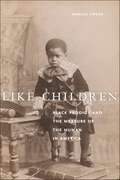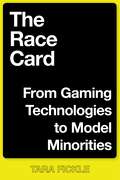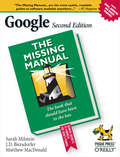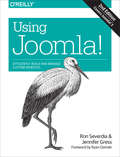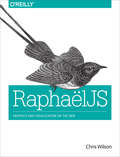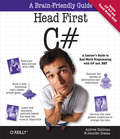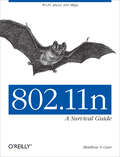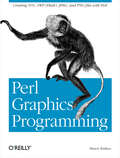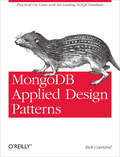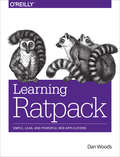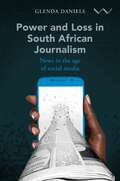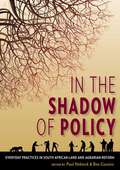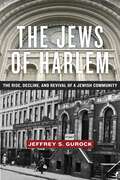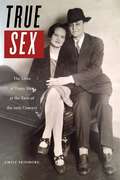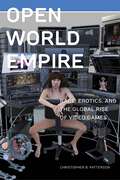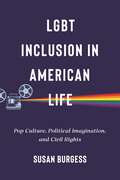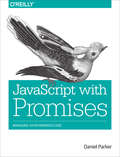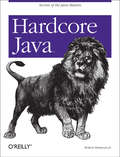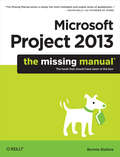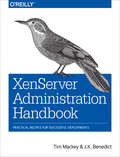- Table View
- List View
Muhammad in the Seminary: Protestant Teaching about Islam in the Nineteenth Century
by David D. GraftonUncovers what Christian seminaries taught about Islam in their formative yearsThroughout the nineteenth century, Islam appeared regularly in the curricula of American Protestant seminaries. Islam was not only the focus of Christian missions, but was studied as part of the history of the Church as well as in the new field of comparative religions. Moreover, Arabic was taught as a cognate biblical language to help students better understand biblical Hebrew. Passages from the Qur’an were sometimes read as part of language instruction.Christian seminaries were themselves new institutions in the nineteenth century. Though Islam had already been present in the Americas since the beginning of the slave trade, it was only in the nineteenth century that the American public became more aware of Islam and had increasing contact with Muslims. It was during this period that extensive trade with the Ottoman empire emerged and more feasible travel opportunities to the Middle East became available due to the development of the steamship. Providing an in-depth look at the information about Islam that was available in seminaries throughout the nineteenth century, Muhammad in the Seminary examines what Protestant seminaries were teaching about this tradition in the formative years of pastoral education. In charting how American Christian leaders’ ideas about Islam were shaped by their seminary experiences, this volume offers new insight into American religious history and the study of Christian-Muslim relations.
Like Children: Black Prodigy and the Measure of the Human in America (Performance and American Cultures)
by Camille OwensA new history of manhood, race, and hierarchy in American childhoodLike Children argues that the child has been the key figure giving measure and meaning to the human in thought and culture since the early American period. Camille Owens demonstrates that white men’s power at the top of humanism’s order has depended on those at the bottom. As Owens shows, it was childhood’s modern arc—from ignorance and dependence to reason and rights—that structured white men’s power in early America: by claiming that black adults were like children, whites naturalized black subjection within the American family order. Demonstrating how Americans sharpened the child into a powerful white supremacist weapon, Owens nevertheless troubles the notion that either the child or the human have been figures of unadulterated whiteness or possess stable boundaries.Like Children recenters the history of American childhood around black children and rewrites the story of the human through their acts. Through the stories of black and disabled children spectacularized as prodigies, Owens tracks enduring white investment in black children’s power and value, and a pattern of black children performing beyond white containment. She reconstructs the extraordinary interventions and inventions of figures such as the early American poet Phillis Wheatley, the nineteenth-century pianist Tom Wiggins (Blind Tom), a child known as “Bright” Oscar Moore, and the early-twentieth century “Harlem Prodigy,” Philippa Schuyler, situating each against the racial, gendered, and developmental rubrics by which they were designated prodigious exceptions. Ultimately, Like Children displaces frames of exclusion and dehumanization to explain black children’s historical and present predicament, revealing the immense cultural significance that black children have negotiated and what they have done to reshape the human in their own acts.
The Race Card: From Gaming Technologies to Model Minorities (Postmillennial Pop #22)
by Tara FickleWinner, 2020 American Book Award, given by the Before Columbus FoundationHow games have been used to establish and combat Asian American racial stereotypes As Pokémon Go reshaped our neighborhood geographies and the human flows of our cities, mapping the virtual onto lived realities, so too has gaming and game theory played a role in our contemporary understanding of race and racial formation in the United States. From the Chinese Exclusion Act and Japanese American internment to the model minority myth and the globalization of Asian labor, Tara Fickle shows how games and game theory shaped fictions of race upon which the nation relies. Drawing from a wide range of literary and critical texts, analog and digital games, journalistic accounts, marketing campaigns, and archival material, Fickle illuminates the ways Asian Americans have had to fit the roles, play the game, and follow the rules to be seen as valuable in the US. Exploring key moments in the formation of modern US race relations, The Race Card charts a new course in gaming scholarship by reorienting our focus away from games as vehicles for empowerment that allow people to inhabit new identities, and toward the ways that games are used as instruments of soft power to advance top-down political agendas. Bridging the intellectual divide between the embedded mechanics of video games and more theoretical approaches to gaming rhetoric, Tara Fickle reveals how this intersection allows us to overlook the predominance of game tropes in national culture. The Race Card reveals this relationship as one of deep ideological and historical intimacy: how the games we play have seeped into every aspect of our lives in both monotonous and malevolent ways.
Google: The Missing Manual (Google: The Missing Manual)
by Rael Dornfest J. D. Biersdorfer Sarah Milstein Matthew MacDonaldGoogle.com is one of the most popular sites on the Internet and is used around the world by millions of people every day. Sure, you know how to "Google it" when you're searching for something--anything!--on the Web. It's plenty fast and easy to use. But did you know how much more you could achieve with the world's best search engine by clicking beyond the "Google Search" button?While you can interface with Google in 97 languages and glean results in 35, you can't find any kind of instruction manual from Google. Lucky for you, our fully updated and greatly expanded second edition to the bestselling Google: The Missing Manual covers everything you could possibly want to know about Google, including the newest and coolest--and often most underused (what is Froogle, anyway?)--features. There's even a full chapter devoted to Gmail, Google's free email service that includes a whopping 2.5 GB of space).This wise and witty guide delivers the complete scoop on Google, from how it works to how you can search far more effectively and efficiently (no more scrolling through 168 pages of seemingly irrelevant results); take best advantage of Google's lesser-known features, such as Google Print, Google Desktop, and Google Suggest; get your website listed on Google; track your visitors with Google Analytics; make money with AdWords and AdSense; and much more.Whether you're new to Google or already a many-times-a-day user, you're sure to find tutorials, tips, tricks, and tools that take you well beyond simple search to Google gurudom.
Using Joomla!: Efficiently Build and Manage Custom Websites
by Ron Severdia Jennifer GressIf you’re new to content management systems—or even new to building websites—this practical guide will get you up and running in no time. You don’t have to know much code, if any, to get started.Need to build a website quickly? Have a client that requires a powerful website with lots of compelling features? Ideal for web designers and developers alike, this updated edition takes you step-by-step through site creation with Joomla, with plenty of hands-on exercises along the way.Build a sample site throughout the book to see how Joomla! worksPlan and structure your site’s categories, articles, menus, and modulesLearn the ins and outs of creating, organizing, and displaying contentAdd images, audio, and video—and create complete image galleriesBuild a blog, set up an events calendar, and create custom user formsSell merchandise by putting together your own online storeEngage visitors by creating user profiles and hangoutsSecure your site and keep it optimizedMigrate to Joomla! 3 and update your third-party extensions
RaphaelJS: Graphics and Visualization on the Web
by Chris WilsonCreate beautiful, interactive images on the Web with RaphaëlJS, the JavaScript library that lets you draw Scalable Vector Graphics (SVG) right in the browser. With this concise guide, you’ll quickly learn how to paint the screen with shapes and colors that you can turn into lively, animated graphics and visualizations.Author Chris Wilson (Time.com) shows you how to create Raphaël objects and manipulate them with animation, transformations, and other techniques, using just a few lines of code. Packed with working examples, sample code, and cool hands-on projects, RaphaëlJS is ideal for new and experienced JavaScript programmers alike.Create images that work on browsers new and old, as well as mobile devicesStart with the basics—shapes, colors, transformations, sets, and textLearn how to build custom curves and shapes with pathsCode animations that move through space, follow paths, or change directionMake your artwork come alive through user interactionBind a dataset to a collection of visual objects—the basis of data visualizationLearn techniques to make your detailed visuals stand out on screens of any size
MediaWiki: Wikipedia and Beyond (Wikipedia and Beyond)
by Daniel J. Barrett"A good book! It's a nice overview of wiki editing and administration, with pointers to handy extensions and further online documentation."-Brion Vibber, Chief Technical Officer, Wikimedia Foundation "This book is filled with practical knowledge based on experience. It's not just spouting some party line."-Rob Church, a developer of MediaWikiMediaWiki is the world's most popular wiki platform, the software that runs Wikipedia and thousands of other websites. Though it appears simple to use at first glance, MediaWiki has extraordinarily powerful and deep capabilities for managing and organizing knowledge. In corporate environments, MediaWiki can transform the way teams write and collaborate.This comprehensive book covers MediaWiki's rich (and sometimes subtle) features, helping you become a wiki expert in no time. You'll learn how to:Find your way around by effective searching and browsingCreate and edit articles, categories, and user preferencesUse advanced features for authors, such as templates, dynamic lists, logical parser functions, and RSS, to organize and maintain large numbers of articlesInstall and run your own wiki, and configure its look and behaviorDevelop custom wiki features, called extensions, with the PHP programming language and MySQL databaseThis book also provides special guidance for creating successful corporate wikis. For beginners who want to create or work on collaborative, community-driven websites with this platform, MediaWiki is the essential one-stop guide."I was a MediaWiki newbie before reading this book. Now, many aspects of the platform that were murky before are crystal clear."-JP Vossen, author of O'Reilly's Bash Cookbook
Head First C# (Head First)
by Jennifer Greene Andrew StellmanHead First C# is a complete learning experience for object-oriented programming, C#, and the Visual Studio IDE. Built for your brain, this book covers C# 3.0 and Visual Studio 2008, and teaches everything from language fundamentals to advanced topics including garbage collection, extension methods, and double-buffered animation. You'll also master C#'s hottest and newest syntax, LINQ, for querying SQL databases, .NET collections, and XML documents. By the time you're through, you'll be a proficient C# programmer, designing and coding large-scale applications.Every few chapters you will come across a lab that lets you apply what you've learned up to that point. Each lab is designed to simulate a professional programming task, increasing in complexity until-at last-you build a working Invaders game, complete with shooting ships, aliens descending while firing, and an animated death sequence for unlucky starfighters. This remarkably engaging book will have you going from zero to 60 with C# in no time flat.
802.11n: Wi-Fi Above 100 Mbps
by Matthew S. GastWireless has finally come of age. With a significant jump in throughput over previous standards, 802.11n is the first wireless technology that doesn’t trade speed for mobility, and users have stormed onto wireless networks with a passion. In this concise guide, Matthew Gast—chair of the IEEE group that produced revision 802.11-2012—shows you why wireless has become the default method of connecting to a network, and provides technical details you need to plan, design, and deploy 802.11n today.Building a network for the multitude of new devices is now a strategic decision for network engineers everywhere. This book gives you an in-depth look at key parts of 802.11n, and shows you how to achieve an Ethernet-free wireless office.Learn how MIMO’s multiple data streams greatly increase wireless speedDiscover how 802.11n modifications improve MAC efficiencyExamine advanced PHY features such as beanforming and space-time code blockUse advanced MAC features to maintain interoperability with older devicesPlan an 802.11n network by determining traffic demand, key applications, power requirements, and securityChoose the architecture, select hardware, and plan coverage to design and build your network
HTML & XHTML: The Definitive Guide
by Bill Kennedy Chuck MuscianoHTML and its XML-based descendant, XHTML, are the fundamental languages for working on the web, and the new edition of our popular HTML guide offers web developers a better way to become fluent in these languages. HTML & XHTML: The Definitive Guide, 5th Edition is the most comprehensive, up-to-date book available on HTML and XHTML. It covers Netscape Navigator 6, Internet Explorer 6, HTML 4.01, XHTML 1.0, CSS2, and all of the features supported by the popular web browsers.Learning HTML and XHTML is like learning any new language. Most students first immerse themselves in examples. Studying others is a natural way to learn; however, it's as easy to learn bad habits through imitation as it is to acquire good ones. The better way to become HTML-fluent is through a comprehensive reference that covers the language syntax, semantics, and variations in detail and demonstrates the difference between good and bad usage.In HTML & XHTML: The Definitive Guide, the authors cover every element of HTML/XHTML in detail, explaining how each element works and how it interacts with other elements. Tips about HTML/XHTML style help you write documents ranging from simple online documentation to complex presentations. With hundreds of examples, the book gives you models for writing your own effective web pages and for mastering advanced features like style sheets and frames.HTML & XHTML: The Definitive Guide, 5th Edition, shows how to:Use style sheets to control a document's appearanceWork with programmatically generated HTMLCreate tables, from simple to complexUse frames to coordinate sets of documentsDesign and build interactive forms and dynamic documentsInsert images, sound files, video, Java applets, and JavaScript programsCreate documents that look good on a variety of browsersMake the transition to XHTMLThe book comes with a handy quick-reference card listing HTML/XHTML tags.
Perl Graphics Programming: Creating SVG, SWF (Flash), JPEG and PNG files with Perl (O'reilly Ser.)
by Shawn WallaceGraphics programmers aren't the only ones who need to be proficient with graphics. Web and applications programmers know that a dull web page can be quickly transformed into one that's interesting and lively with the use of well-planned graphics. And fortunately, you don't need the skills of a fulltime graphics programmer to use graphics effectively. From access counters and log report graphs to scientific plots and on-the-fly animated GIFs, graphics scripting is within the grasp of most web programmers. Using open source software, like Perl, you have the power to dynamically generate graphics based on user input and activity, easily manipulate graphics content, and optimize graphics for compression and quality.Geared toward Perl users and webmasters, Perl Graphics Programming focuses on open-source scripting programs that manipulate graphics files for use on the Web. The book demystifies the manipulation of graphics formats for newcomers to the Web with a practical, resource-like approach. With this book you'll learn to:Generate dynamic web graphics with charts, tables, and buttonsAutomate graphics tasks (thumbnails and borders)Create dynamics web documents (PDF, Postscript)Produce rich Internet experiences with Flash and SVGYou'll begin with a tour of the most common web graphic file formats--PNG, JPEG, GIF, SWF, SVG, Postscript and PDF--then you'll explore the most powerful tools and Perl modules available for manipulating these graphics, such as GD, PerlMagick, and GIMP. Included in this part of the book is a thorough description of the Ming module for creating on-the-fly Flash files. Next, a "cookbook" section includes practical, all purpose recipes: GIF animation, generating images within a dynamic application, communicating between SWF front-end and Perl back-end, XSLT transformations, compression, and much more.Perl programmers naturally turn to Perl to tackle whatever challenge they have at hand, and graphics programming is no exception. Perl Graphics Programming provides all the tools you need to begin programming and designing graphics for the Web immediately. This book will change how you think about generating and manipulating graphics for the Web.
MongoDB Applied Design Patterns: Practical Use Cases with the Leading NoSQL Database
by Rick CopelandWhether you’re building a social media site or an internal-use enterprise application, this hands-on guide shows you the connection between MongoDB and the business problems it’s designed to solve. You’ll learn how to apply MongoDB design patterns to several challenging domains, such as ecommerce, content management, and online gaming. Using Python and JavaScript code examples, you’ll discover how MongoDB lets you scale your data model while simplifying the development process.Many businesses launch NoSQL databases without understanding the techniques for using their features most effectively. This book demonstrates the benefits of document embedding, polymorphic schemas, and other MongoDB patterns for tackling specific big data use cases, including:Operational intelligence: Perform real-time analytics of business dataEcommerce: Use MongoDB as a product catalog master or inventory management systemContent management: Learn methods for storing content nodes, binary assets, and discussionsOnline advertising networks: Apply techniques for frequency capping ad impressions, and keyword targeting and biddingSocial networking: Learn how to store a complex social graph, modeled after Google+Online gaming: Provide concurrent access to character and world data for a multiplayer role-playing game
Learning Ratpack: Simple, Lean, and Powerful Web Applications
by Dan WoodsBuild robust, highly scalable reactive web applications with Ratpack, the lightweight JVM framework. With this practical guide, you’ll discover how asynchronous applications differ from more traditional thread-per-request systems—and how you can reap the benefits of complex non-blocking through an API that makes the effort easy to understand and adopt.Author Dan Woods—a member of the Ratpack core team—provides a progressively in-depth tour of Ratpack and its capabilities, from basic concepts to tools and strategies to help you construct fast, test-driven applications in a semantic and expressive way. Ideal for Java web developers familiar with Grails or Spring, this book is applicable to all versions of Ratpack 1.x.Configure your applications and servers to accommodate the cloudUse Ratpack testing structures on both new and legacy applicationsAdd advanced capabilities, such as component binding, with modulesExplore Ratpack’s static content generation and serving mechanismsProvide a guaranteed execution order to asynchronous processingModel data and the data access layer to build high-performance, data-driven applicationsWork with reactive and functional programming strategiesUse distribution techniques that support continuous delivery and other deployment tactics
Power and Loss in South African Journalism: News in the age of social media
by Dr. Glenda DanielsThis timely collection of essays analyses the crisis of journalism in contemporary South Africa at a period when the media and their role are frequently at the centre of public debate. The transition to digital news has been messy, random and unpredictable. The spread of news via social media platforms has given rise to political propaganda, fake news and a flattening of news to banality and gossip. Media companies, however, continue to shrink newsrooms, ousting experienced journalists in favour of 'content producers'.Against this backdrop, Daniels points out the contribution of investigative journalists to exposing corruption and sees new opportunities emerging to forge a model for the future of non-profit, public-funded journalism. Engaging and dynamic, the book argues for the power of public interest journalism, including investigative journalism, and a diversity of voices and positions to be reflected in the news. It addresses the gains and losses from decolonial and feminist perspectives and advocates for a radical shift in the way power is constituted by the media in the South African postcolony.A valuable introduction to the confusion that confronts journalism students, it has much to offer practising media professionals. Daniels uses her years of experience as a newspaper journalist to write with authority and illuminate complex issues about newsroom politics. Interviews with alienated media professionals and a semi-autobiographical lens add a personal element that will appeal to readers interested in the inner life of the media.
Re-Imagining Black Women: A Critique of Post-Feminist and Post-Racial Melodrama in Culture and Politics
by Nikol G. Alexander-FloydWINNER OF THE W.E.B. DUBOIS DISTINGUISHED BOOK AWARD, GIVEN BY THE NATIONAL CONFERENCE OF BLACK POLITICAL SCIENTISTSA wide-ranging Black feminist interrogation, reaching from the #MeToo movement to the legacy of gender-based violence against Black womenFrom Michelle Obama to Condoleezza Rice, Black women are uniquely scrutinized in the public eye. In Re-Imagining Black Women, Nikol G. Alexander-Floyd explores how Black women—and Blackness more broadly—are understood in our political imagination and often become the subjects of public controversy. Drawing on politics, popular culture, psychoanalysis, and more, Alexander-Floyd examines our conflicting ideas, opinions, and narratives about Black women, showing how they are equally revered and reviled as an embodiment of good and evil, cast either as victims or villains, citizens or outsiders. Ultimately, Alexander-Floyd showcases the complex experiences of Black women as political subjects. At a time of extreme racial tension, Re-Imagining Black Women provides insight into the parts that Black women play, and are expected to play, in politics and popular culture.
In the Shadow of Policy: Everyday Practices in South Africa's Land and Agrarian Reform
by Paul Hebinck Ben Cousins Henning de Klerk Jonathan Denison Ntombekhaya Faku Derick Fay Klara Jacobson Petunia Khutswane Rosalie Kingwill Karin Kleinbooi Zamile Madyibi Francois Marais Modise Moseki Malebogo Phetlhu Robert Ross Dik Roth Limpho Taoana Harriët Tienstra Wim van Averbeke Yves van LeynseeleNotions of land and agrarian reform are now well entrenched in post-apartheid South Africa. But what this reform actually means for everyday life is not clearly understood, nor the way it will impact on the political economy. In the Shadow of Policy explores the interface between the policy of land and agrarian reform and its implementation; and between the decisions of policy ‘experts’ and actual livelihood experiences in the fields and homesteads of land reform projects.Starting with an overview of the socio-historical context in which land and agrarian reform policy has evolved in South Africa, the volume presents empirical case studies of land reform projects in the Northern, Western and Eastern Cape provinces. These draw on multiple voices from various sectors and provide a rich source of material and critical reflections to inform future policy and research agendas.In the Shadow of Policy will be a key reference tool for those working in the area of development studies and land policy, and for civil society groups and NGOs involved in land restitution.
The Jews of Harlem: The Rise, Decline, and Revival of a Jewish Community
by Jeffrey S. GurockThe complete story of Jewish Harlem and its significance in American Jewish historyNew York Times columnist David W. Dunlap wrote a decade ago that “on the map of the Jewish Diaspora, Harlem Is Atlantis. . . . A vibrant hub of industry, artistry and wealth is all but forgotten. It is as if Jewish Harlem sank 70 years ago beneath waves of memory beyond recall.” During World War I, Harlem was the home of the second largest Jewish community in America. But in the 1920s Jewish residents began to scatter to other parts of Manhattan, to the outer boroughs, and to other cities. Now nearly a century later, Jews are returning uptown to a gentrified Harlem. The Jews of Harlem follows Jews into, out of, and back into this renowned metropolitan neighborhood over the course of a century and a half. It analyzes the complex set of forces that brought several generations of central European, East European, and Sephardic Jews to settle there. It explains the dynamics that led Jews to exit this part of Gotham as well as exploring the enduring Jewish presence uptown after it became overwhelmingly black and decidedly poor. And it looks at the beginnings of Jewish return as part of the transformation of New York City in our present era. The Jews of Harlem contributes much to our understanding of Jewish and African American history in the metropolis as it highlights the ever-changing story of America’s largest city. With The Jews of Harlem, the beginning of Dunlap’s hoped-for resurfacing of this neighborhood’s history is underway. Its contemporary story merits telling even as the memories of what Jewish Harlem once was warrants recall.
True Sex: The Lives of Trans Men at the Turn of the Twentieth Century
by Emily SkidmoreWinner, 2018 U.S. History PROSE AwardThe incredible stories of how trans men assimilated into mainstream communities in the late 1800sIn 1883, Frank Dubois gained national attention for his life in Waupun, Wisconsin. There he was known as a hard-working man, married to a young woman named Gertrude Fuller. What drew national attention to his seemingly unremarkable life was that he was revealed to be anatomically female. Dubois fit so well within the small community that the townspeople only discovered his “true sex” when his former husband and their two children arrived in the town searching in desperation for their departed wife and mother.At the turn of the twentieth century, trans men were not necessarily urban rebels seeking to overturn stifling gender roles. In fact, they often sought to pass as conventional men, choosing to live in small towns where they led ordinary lives, aligning themselves with the expectations of their communities. They were, in a word, unexceptional. In True Sex, Emily Skidmore uncovers the stories of eighteen trans men who lived in the United States between 1876 and 1936. Despite their “unexceptional” quality, their lives are surprising and moving, challenging much of what we think we know about queer history. By tracing the narratives surrounding the moments of “discovery” in these communities – from reports in local newspapers to medical journals and beyond – this book challenges the assumption that the full story of modern American sexuality is told by cosmopolitan radicals. Rather, True Sex reveals complex narratives concerning rural geography and community, persecution and tolerance, and how these factors intersect with the history of race, identity and sexuality in America.
Open World Empire: Race, Erotics, and the Global Rise of Video Games (Postmillennial Pop #26)
by Christopher B. PattersonFinalist, 2021 John Hope Franklin Prize, given by the American Studies AssociationSeeking ways to understand video games beyond their imperial logics, Patterson turns to erotics to re-invigorate the potential passions and pleasures of playVideo games vastly outpace all other mediums of entertainment in revenue and in global reach. On the surface, games do not appear ideological, nor are they categorized as national products. Instead, they seem to reflect the open and uncontaminated reputation of information technology. Video games are undeniably imperial products. Their very existence has been conditioned upon the spread of militarized technology, the exploitation of already-existing labor and racial hierarchies in their manufacture, and the utopian promises of digital technology. Like literature and film before it, video games have become the main artistic expression of empire today: the open world empire, formed through the routes of information technology and the violences of drone combat, unending war, and overseas massacres that occur with little scandal or protest.Though often presented as purely technological feats, video games are also artistic projects, and as such, they allow us an understanding of how war and imperial violence proceed under signs of openness, transparency, and digital utopia. But the video game, as Christopher B. Patterson argues, is also an inherently Asian commodity: its hardware is assembled in Asia; its most talented e-sports players are of Asian origin; Nintendo, Sony, and Sega have defined and dominated the genre. Games draw on established discourses of Asia to provide an “Asiatic” space, a playful sphere of racial otherness that straddles notions of the queer, the exotic, the bizarre, and the erotic. Thinking through games like Overwatch, Call of Duty 4: Modern Warfare, Shenmue II, and Alien: Isolation, Patterson reads against empire by playing games erotically, as players do—seeing games as Asiatic playthings that afford new passions, pleasures, desires, and attachments.
Governing Complex City-Regions in the Twenty-First Century: Brazil, Russia, India, China, and South Africa
by Philip HarrisonExplores the challenges of large, complex, institutionally fragmented, and dynamic city-regions across the BRICS countries and the emergence of formal and informal governance arrangements.
LGBT Inclusion in American Life: Pop Culture, Political Imagination, and Civil Rights (LGBTQ Politics #4)
by Susan BurgessA compelling explanation of the American public’s acceptance of LGBT freedoms through the lens of pop cultureHow did gay people go from being characterized as dangerous perverts to military heroes and respectable parents? How did the interests of the LGBT movement and the state converge to transform mainstream political and legal norms in these areas?Using civil rights narratives, pop culture, and critical theory, LGBT Inclusion in American Life tells the story of how exclusion was transformed into inclusion in US politics and society, as pop culture changed mainstream Americans thinking about “non-gay” issues, namely privacy, sex and gender norms, and family. Susan Burgess explores films such as Casablanca, various James Bond movies, and Julie and Julia, and television shows such as thirtysomething and The Americans, as well as the Broadway sensation Hamilton, as sources of growing popular support for LGBT rights. By drawing on popular culture as a rich source of public understanding, Burgess explains how the greater public came to accept and even support the three central pillars of LGBT freedoms in the post–World War II era: to have consensual adult sex without fear of criminal penalty, to serve openly in the military, and to marry legally. LGBT Inclusion in American Life argues that pop culture can help us to imagine unknown futures that lead beyond what we currently desire from contemporary politics, and in return asks now that the mainstream public has come to accept LGBT freedoms, where might the popular imagination be headed in the future?
JavaScript with Promises: Managing Asynchronous Code
by Daniel ParkerAsynchronous JavaScript is everywhere, whether you’re using Ajax, AngularJS, Node.js, or WebRTC. This practical guide shows intermediate to advanced JavaScript developers how Promises can help you manage asynchronous code effectively—including the inevitable flood of callbacks as your codebase grows. You’ll learn the inner workings of Promises and ways to avoid difficulties and missteps when using them.The ability to asynchronously fetch data and load scripts in the browser broadens the capabilities of JavaScript applications. But if you don’t understand how the async part works, you’ll wind up with unpredictable code that’s difficult to maintain. This book is ideal whether you’re new to Promises or want to expand your knowledge of this technology.Understand how async JavaScript works by delving into callbacks, the event loop, and threadingLearn how Promises organize callbacks into discrete steps that are easier to read and maintainExamine scenarios you’ll encounter and techniques you can use when writing real-world applicationsUse features in the Bluebird library and jQuery to work with PromisesLearn how the Promise API handles asynchronous errorsExplore ECMAScript 6 language features that simplify Promise-related code
Hardcore Java: Secrets of the Java Masters
by Robert Simmons JrJava has quickly become one of the most important languages in programming, particularly for professional and enterprise-level projects. From its infancy as a language primarily used for web applets to its maturity through servlets, Enterprise JavaBeans, and database access, Java has become a complex and robust tool for today's developer.Hardcore Java takes this language and breaks it apart, piece by piece, revealing the important secrets and tricks that will take you from a junior-level programmer to a seasoned and expert developer. You'll fly through the fundamentals and quickly find yourself learning about advanced memory management techniques, optimization and bytecode-level enhancements, and the techniques required to build lightning-fast GUIs. Throughout the book, you'll also master the art of writing and maintaining bulletproof and error-proof code, all while grasping the intricacies of the Java language.Hardcore Java covers:Use of the final keyword to optimize and protect your Java classes.Complete and thorough coverage of all types of nested classes, including how to optimize anonymous and inner classes.Detailed discussion of immutable objects, including unique tips on when to use them (and when not to).Elimination of bugs through exception-handling management.In-depth studies of constants, including their impact on the Java memory model.The most thorough discussion of reflection in print, moving far beyond other books' "Hello World" coverage.Construction and use of dynamic proxies, in both Java Standard and Enterprise editions.Expansive coverage of weak references, including usage patterns and their role in garbage collection and memory management.Hardcore Java is an invaluable addition to every programmer's library, and even the most advanced developers will find themselves moving beyond their own conceptions into truly advanced applications of the language. Thousands of lines of code, heavily commented and easily runnable, illustrate each concept in the book.
Microsoft Project 2013: The Missing Manual (The\missing Manual Ser.)
by Bonnie BiaforeGet up to speed on Microsoft Project 2013 and learn how to manage projects large and small. This crystal-clear book not only guides you step-by-step through Project 2013’s new features, it also gives you real-world guidance: how to prep a project before touching your PC, and which Project tools will keep you on target. With this Missing Manual, you’ll go from project manager to Project master.The important stuff you need to knowLearn Project 2013 inside out. Get hands-on instructions for the Standard and Professional editions.Start with a project management primer. Discover what it takes to handle a project successfully.Build and refine your plan. Put together your team, schedule, and budget.Achieve the results you want. Build realistic schedules with Project, and learn how to keep costs under control.Track your progress. Measure your performance, make course corrections, and manage changes.Create attractive reports. Communicate clearly to stakeholders and team members using charts, tables, and dashboards.Use Project’s power tools. Customize Project’s features and views, and transfer info via the cloud, using Microsoft SkyDrive.
XenServer Administration Handbook: Practical Recipes for Successful Deployments
by J. K. Benedict Tim MackeyPacked with practical advice, this hands-on guide provides valuable information you need to most effectively optimize and manage the XenServer open source virtualization platform. Whether you run a modest installation of a few blades or multiple global enterprise datacenters, this book focuses on the most critical issues you’re likely to encounter when designing a XenServer deployment and helps you handle day-to-day management tasks.Tim Mackey and J.K. Benedict from Citrix Systems, the company that manages XenServer, show you how to design a deployment through best practices, deployment blueprints, and installation guidelines. The book’s second part features concise, easy-to-implement recipes for day-to-day management, such as user rights, backup strategies, and hardware maintenance.Learn precisely what makes a XenServer work, and how it can host 1000 virtual machinesExplore the core components of a production XenServer environmentInvestigate several options on how and where to install XenServerExamine several factors for "right sizing" your XenServer deployment to fit your needsWork with a decision tree to optimize your XenServer deployment designUnderstand how to accommodate guest VM virtualization modesUse recipes that help you plan for, obtain, and apply XenServer upgrades

